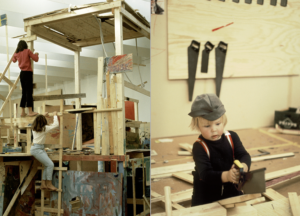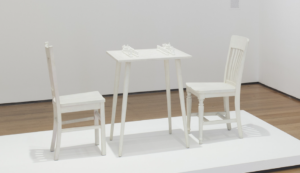Play and Participation in Contemporary Arts Practices (Stott, Tim, 2015)
Precursors to Ludic Participation
‘diverse arts practices moved away from the studio-to-gallery model of artistic production and began to investigate more performance-based or event-based models’ (pg 16). using specific artwork examples, this chapter looks into how artists manifest an idea of participation and play in their works and how these examples fit into theories of play.
humanistic– ‘allows players to take pleasure in mastery’
post-humanistic– ‘to be in play is to be played…mutually entangled and conditioned upon other player/objects/dynamics’

The Model- A Model for a Qualitative Society (Palle Nielsen, 1968) was a large-scale ‘adventure playground’ situated within Modern Museet, Stockholm for three weeks and saw 20,000 children participate. ‘Nielsen believed the spontaneous, self-organising children’s play to be an instance of a living community that could serve as a model for adult society’ (pg 17). this work fits into a humanist argument of ‘play as the optimal achievement of a human agent…most free’ (pg 18). as an ever-evolving piece, having tools shared to continue the construction, it fits into Reichadt’s four categories of toys and play objects as ‘must involve participation in its construction’. to achieve the ‘most free’ form of being, one cannot give out or rely upon rules that would constrain play, leaving an allowance for an ability for the player to maneuver and manipulate a space freely. an interesting contender for this way of theorising play is Victor Newsome’s example of a girl playing with a doll, observed by her mother (pg 23). this is outlined as an ‘entanglement’ (pg 29), with all the elements interacting with one another. these elements are: to the girl, the doll is a real child like the girl playing with it; the mother is also participating in this play as the child’s play turns into a plaything she is getting enjoyment from. there is also the variable of the child’s interaction with the doll as a set-up for her as learnt behaviours from her mother. this example depicts a need to theorise play, not just as having an embodied ‘freeness’, as dependable on a set of variables that determine play and how something will be engaged with.

https://www.moma.org/audio/playlist/15/385
later in this chapter, an example of play was Yoko Ono’s, White Chess Set, 1966. i thought this was interesting as by removing the black and white rule of playing with a chess set, Ono is eliminating any insinuation of ‘war’ within the game and what is left is ‘negotiation’. of course playing chess is possible but players must know where all their pieces are on the board, thus turning into more of a memory game where the chess rules are not as valued by the participants. due to this modification of the game ‘players have the capacity to redefine the conditions of their play’ (pg 28), allowing or encouraging participants to to negotiate a way of playing or to set their own rules entirely. this allows players to be present in the construction of game rules which could be ‘remade with each play’ and enables players ‘increase
complexity in participation, and to prompt players to organise in their play according to the changed conditions of the game itself.’ (pg 29)
(https://www.macba.cat/en/learn-explore/publications/palle-nielsen-model-model-qualitative-society)

Leave a Reply